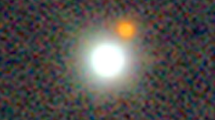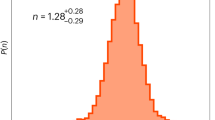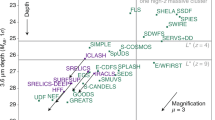Abstract
Cosmic strings are topologically stable defects in the vacuum which may be produced at a phase transition in the early Universe. Some may form closed loops, and some may be open, extending over the entire observable Universe. Although gravitational lensing of distant quasars by cosmic strings has been discussed1–6 it is difficult to prove that a particular pair of quasar images is formed by a cosmic string. We suggest here that observations of very distant galaxies are more useful as a means for their discovery. A galaxy may appear as cut by a sharp edge if there is a cosmic string between the galaxy and the observer. We argue that if there is only one string out to a redshift z≍1, then the probability that it crosses a random image obtained with the Wide Field Camera (WFC) of the Space Telescope is ˜10−4. Therefore, there is a fair chance of discovering a string, after taking 104 images. The WFC will operate almost continuously in primary and serendipity modes, and a cosmic string, if it exists, may be discovered using the Space Telescope within the first few years of its operation.
This is a preview of subscription content, access via your institution
Access options
Subscribe to this journal
Receive 51 print issues and online access
$199.00 per year
only $3.90 per issue
Buy this article
- Purchase on Springer Link
- Instant access to full article PDF
Prices may be subject to local taxes which are calculated during checkout
Similar content being viewed by others
References
Zeldovich Ya, B. Mon. Not. R. astr. Soc. 192, 663–667 (1980).
Vilenkin, A. Phys. Rev. D23, 852–858 (1981).
Vilenkin, A. Phys. Rev. Lett. 46, 1169–1171 (1981).
Vilenkin, A. Astrophys. J. Lett. 282, L51–L53 (1984).
Hogan, C. & Narayan, R. Mon Not. R. astr. Soc. 211, 575–591 (1984).
Gott, J. R. Astrophys. J. 288, 422–427 (1985).
Arp, H. & Hazard, C. Astrophys. J. 240, 726–736 (1980).
Burbidge, E. M. et al. Astrophys. J. Lett. 242, L55L57 (1980).
MacAlpine, G. M. & Smith, H. E. Astrophys. J. 261, 412–421 (1982).
Shaver, P. A. & Robertson, J. G. Astrophys. J. Lett. 268, L57–L61 (1983).
Arp, H. Astrophys. J. 271, 479–506 (1983).
Surdej, J., Swings, J. P., Henry, A., Arp, H., Kruszewski, A. & Pedersen, H. Proc. 24th Liége Int. Astrophys. Colloq. (ed. Swings, J. P.) 355–359 (1983).
Paczyński, B. & Górski, K. Astrophys. J. Lett. 248, L101–L104 (1981).
Sanders, R. H., Van Albada, T. S. & Oosterloo, T. A. Astrophys. J. Lett. 278, L91–L94 (1984).
Oort, J. H., Arp, H. & Ruiter, H. Astr. Astrophys. 95, 7–13 (1981).
Osterbrock, D. E. & Shuder, J. M. Astrophys. J. Suppl. 49, 149–174 (1982).
Gaskell, C. M. Astrophys. J. 263, 79–86 (1982).
Shuder, J. M. Astrophys. J. 280, 491–498 (1984).
Wilkes, B. J. Mon. Not. R. astr. Soc. 207, 73–98 (1984).
Baldwin, J. A. Astrophys. J. 201, 26–44 (1975).
Heckman, T. M., Miley, G. K. & Green, R. F. Astrophys. J. 281, 525–534 (1984).
Gunn, J. IAU Colloq. No. 54, 313–319 (NASA CP-2111, 1979).
Tyson, J. A. & Jarvis, J. F. Astrophys. J. Lett. 230, L153–L156 (1979).
Bahcall, J. N. & O'Dell, C. R. IAU Colloq. No. 54, 5–46 (NASA CP-2111, 1979).
Author information
Authors and Affiliations
Rights and permissions
About this article
Cite this article
PaczyŃski, B. Will cosmic strings be discovered using the Space Telescope?. Nature 319, 567–568 (1986). https://doi.org/10.1038/319567a0
Received:
Accepted:
Issue Date:
DOI: https://doi.org/10.1038/319567a0
This article is cited by
-
Space fabric wrinkles: history of observational searches for exotic structures in the Universe
La Rivista del Nuovo Cimento (2021)
-
Lensing by exotic objects
General Relativity and Gravitation (2010)
-
Marginal gravitational lenses of large separation: probing superclusters
Nature (1987)
Comments
By submitting a comment you agree to abide by our Terms and Community Guidelines. If you find something abusive or that does not comply with our terms or guidelines please flag it as inappropriate.



